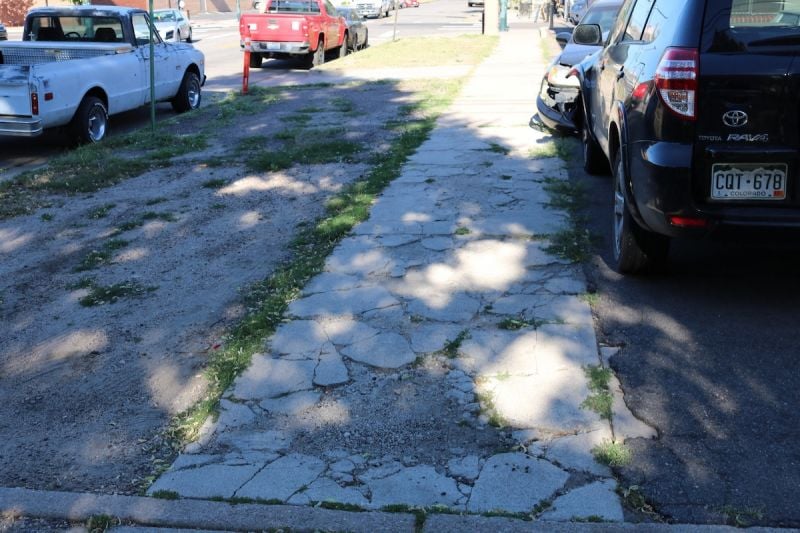
Cracks in a sidewalk. (Photo by Matheus Natan / Pexels)
Denver has a sidewalk problem. About 40% of its sidewalks are missing or don’t meet the standards of the Americans with Disabilities Act. Remarkably, the city’s own plan recommended a fix over 20 years ago: Move responsibility for sidewalk repair from property owners to the city and implement an annual fee to pay for the program.
The fix might seem simple, but it took over 20 years and grassroots advocacy to make it happen.
“In 2022 we just got tired of waiting and decided to do a citizen-initiated ordinance,” says Jill Locantore, executive director of the Denver Streets Partnership, a group of community organizations pushing for multimodal streets in the city. “Which is basically implementing exactly what the city’s own plans had been saying we should do.”
Sidewalk advocates fought and won. The ballot measure, dubbed “Denver Deserves Sidewalks,” swayed 56% of voters. There was no organized opposition to the measure.
“Don’t underestimate how sexy sidewalks are,” says Locantore.
Sidewalk repairs started July 2025.
Could Denver’s program serve as a model?
Denver isn’t alone with its sidewalk woes. Cities across the U.S. are grappling with how to fix broken, narrow sidewalks or build missing ones.
Los Angeles, dubbed “the city of broken sidewalks” in an article by late parking guru Donald Shoup, has roughly 9,300 miles of sidewalk and no clear plan for fixing them.
With the car-free 2028 Summer Olympics looming, the pressure is on to find a solution.
“If people break their hips or knees or wrists falling on a broken sidewalk — what terrible advertising this is for L.A.,” Shoup told Next City last year. “Paris is a city of light, and L.A. will be the city of deferred maintenance.”
In 2010, Angelenos with disabilities sued the city of L.A., alleging that broken and inaccessible sidewalks were a violation of the American with Disabilities Act. In 2016, as part of the Willits settlement, the city agreed to spend about $1.4 billion over 30 years to fix sidewalks, with priority given to requests submitted by residents with mobility disabilities.
Despite the big dollar commitment, most of L.A.’s broken sidewalks remain broken, and experts say that the Willits case has largely failed to improve the pedestrian experience. People with mobility disabilities still wait up to a decade for sidewalk repairs.
“Less than 1% [of sidewalks] have been fixed,” says Jessica Meaney, executive director of Investing in Place, a local nonprofit transportation advocacy group. “So the lawsuit that people thought was going to solve a lot of problems — well, it’s solving some important ones, but at an incredibly slow pace.”
Broken sidewalks don’t just impede mobility for pedestrians; they also come with a huge price tag. L.A. spends millions every year on liability lawsuits caused by broken public infrastructure.
Who should be responsible for sidewalks?
It turns out that pre-2022 Denver is not an outlier: Most major cities expect property owners to foot the bill for fixing sidewalks.
Laura Messier, a researcher in public health and public spaces at the University of Southern California, compared sidewalk policies in the 30 most populated cities in the U.S. To her surprise, she found 77% require the adjacent property owner to fix the sidewalk.
This presents a problem.
“Cities are not enforcing that responsibility because they don’t want resident blowback,” says Messier. “And so it seems like there’s sort of this collective wishful thinking that somehow this critical infrastructure will take care of itself.”
Taking on responsibility for sidewalks means Denver is treating sidewalks as part of its overall transportation system. To fund repairs, most property owners are charged an annual fee of $150. Income-qualified residents can apply for a rebate.
As part of Willits, L.A. has taken on responsibility for sidewalk repairs with the goal of releasing responsibility back to property owners, “fix and release.” However, the pace of repairs is so slow that it’s unclear how the city will achieve this goal. With over 9,000 miles of sidewalk, L.A. is fixing roughly 15 miles and adding 50 curb ramps per year.
“Fear of liability, in my mind, is driving every decision cities are making about sidewalks,” Messier says.
It’s a Sisyphean system: On the hook for millions per year in liability lawsuits, L.A. is also legally required to spend millions per year on a sidewalk program that has yet to make a dent in a backlog of repairs that might prevent future liability lawsuits.
As Meaney has stressed, Los Angeles doesn’t have a sidewalk program — it has the Willits settlement. And Willits doesn’t address street infrastructure as a whole, says Messier. Instead, it mandates that the city spend a certain amount per year on sidewalks. The consequences can prove counterintuitive.
“I think that the city’s finding that some of the places that they’ve fixed are already getting damaged again from tree roots,” Messier says, noting that sidewalks and street trees are managed separately. “We’re spending all this money, but it doesn’t really feel like we’re going to end up with long-term improvement.”

A broken sidewalk in Denver. (Photo by Jeffrey Beall / CC BY-SA 2.0)
The root of the issue is that cities have prioritized infrastructure for cars over all other possible uses of public space. If cities treated streets more holistically, they might be able to prioritize trees and sidewalks.
“Where we might have excess lane capacity for cars, we might be able to widen parkways, widen sidewalks and really solve the tree root-sidewalk conflict so that it doesn’t become a problem in the future,” says Messier.
Are sidewalks having a moment?
There are signs that L.A. residents want better streets for people outside of cars. Last March, voters passed Measure HLA, mandating the city follow its own mobility plan when it repaves streets. Since the measure passed, progress on more bike, pedestrian and bus infrastructure has been slow.
In October, L.A. Mayor Karen Bass signed Executive Directive No. 9 to streamline public infrastructure improvements and create a multi-year plan for projects.
Would L.A. property owners be willing to pay a sidewalk fee? Maybe.
“Let’s look at Denver’s revenue generating [program], let’s look at a bond, let’s look at a sales tax,” says Meaney. “Both inside and outside City Hall, people are like, ‘Wait, this is so broken, let’s fix it.’”
This story was produced through our Equitable Cities Fellowship for Social Impact Design, which is made possible with funding from the National Endowment for the Arts.
This post was originally published on Next City.